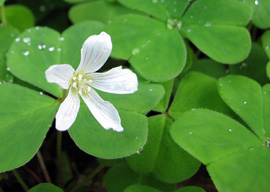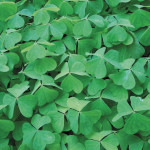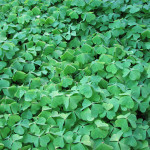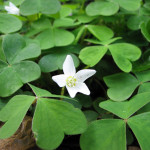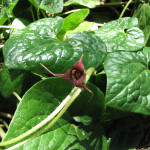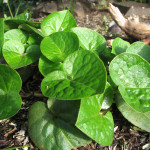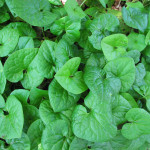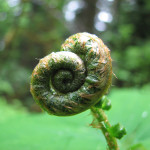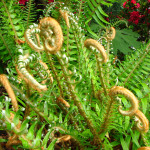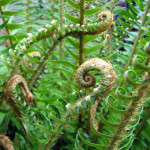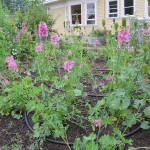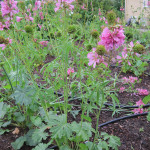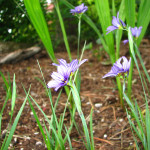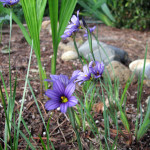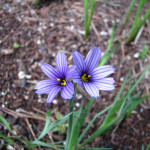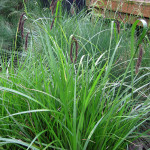Oxalis oregana
Oxalis oregana, also known as Redwood sorrel, is a species of the wood sorrel family, Oxalidaceae, native to moist Douglas-fir and Coast Redwood forests of western North America from southwestern British Columbia, Washington, Oregon, and California. This attractive groundcover can spread vigorously when planted in favorable conditions.
It is a short herbaceous perennial plant with erect flowering stems 5-15 cm tall. The three leaflets are heart-shaped, 1-4.5 cm long on 5-20 cm stalks. The inflorescence is 2.4-4 cm in diameter, white to pink with five petals and sepals. The hairy five-chambered seed capsules are egg-shaped, 7-9 mm long; seeds are almond shaped.
Oregon oxalis photosynthesizes at relatively low levels of ambient light (1/200th of full sunlight). When direct sunlight strikes the leaves they fold downwards; when shade returns, the leaves reopen. This process only takes a few minutes and the movement is observable to the eye.
The tangy leaves of Oregon oxalis were eaten by Native Americans, probably in small quantities, since they contain mildly toxic oxalic acid (hence the genus name).
- Light Requirements: Part Shade, Full Shade
- Water Requirements: Moist
- Ease of Growing: Easy to grow
- Growth Rate: Moderate
- Spreads: Yes
- Wildlife Support: Birds or Mammals
- Fire-resistant: Yes
- Edible: Yes
- Mature Height: 6-8in
- Mature Width:2-3ft
Wild Ginger
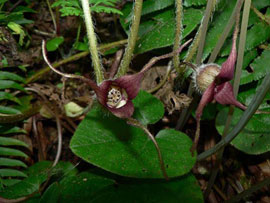
Asarum caudatum
Groundcover with unique maroon flowers hidden under heart-shaped glossy leaves in spring; it has edible roots.
- Light Requirements: Part Shade, Full Shade
- Water Requirements: Moist
- Ease of Growing: Moderate, Difficult
- Growth Rate: Moderate
- Spreads: Yes
- Wildlife Support: Pest-eating Insects, Birds or Mammals
- Fire-resistant: No
- Edible: Yes
- Mature Height: 6in
- Mature Width:3ft
Sword Fern
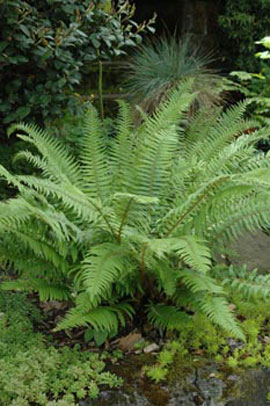
Polystichum munitum
Polystichum munitum (Western Sword Fern) is an evergreen fern native to western North America, where it is one of the most abundant ferns occurring along the Pacific coast from southeast Alaska south to southern California, and also inland east to southeastern British Columbia, northern Idaho and western Montana, with isolated populations in interior northern British Columbia, the Black Hills in South Dakota, and on Guadalupe Island off Baja California.
The dark green fronds of this fern grow to 50-180 cm tall, in a tight clump spreading out radially from a round base. They are single-pinnate, with the pinnae alternating on the stalk. Each pinna is 1-15 cm long, with a small upward-pointing lobe at the base, and the edges are serrated with bristly tips. Individual fronds live for 1.5-2.5 years and remain attached to the rhizome after withering. The round sori occupy two rows on either side of the midrib of each pinna and are covered by a centrally-attached, umbrella-like indusium with fringed edges. They produce light yellow spores.
The favored habitat of this fern is the understory of moist coniferous forests at low elevations. It grows best in a well-drained acidic soil of rich humus and small stones. Sword ferns are very tough, and can survive occasional dry periods once established.
While this fern is a favored horticultural subject in western North America, it has been found to be difficult or impossible to grow satisfactorily in the eastern part of the continent.
- Light Requirements: Part Shade, Full Shade
- Water Requirements: Dry, Moist
- Ease of Growing: Easy to grow
- Growth Rate: Moderate
- Spreads: No
- Wildlife Support: Birds or Mammals
- Fire-resistant: Yes
- Edible:
- Mature Height: 2-5ft
- Mature Width:2-4ft
Lady Fern
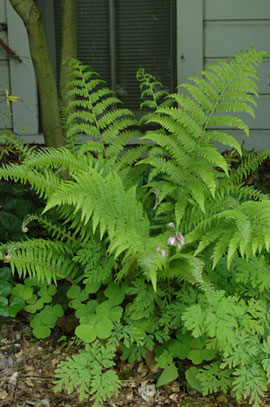
Athyrium filix-femina
Athyrium filix-femina (Lady Fern or Common Lady-fern) is a large, feathery species of fern native throughout most of the temperate Northern Hemisphere, where it is often abundant (one of the more common ferns) in damp, shady woodland environments and is often grown for decoration in shady home gardens.
- Light Requirements: Full Sun, Part Shade, Full Shade
- Water Requirements: Moist, Seasonally Wet
- Ease of Growing: Easy to grow
- Growth Rate: Moderate
- Spreads: No
- Wildlife Support: Hummingbirds, Birds or Mammals
- Fire-resistant: No
- Edible: No
- Mature Height: 4ft
- Mature Width:2ft
Cusick’s Checkermallow
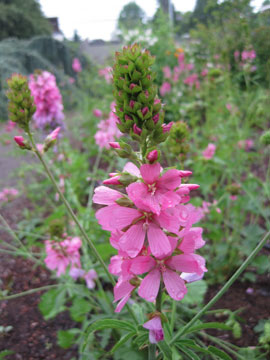
Sidalcea cusickii
A delightful, hollyhock-like perennial rarely found outside its native Oregon, and not in every county. Stands of this perennial have been reported in Washington, Multnomah, Yamhill, Benton, Linn, Lane, Douglas, Coos and Jackson counties, but not all are documented.
- Light Requirements: Full Sun, Part Shade
- Water Requirements: Dry, Moist
- Ease of Growing: Easy to grow
- Growth Rate: Fast
- Spreads:
- Wildlife Support: Pollinators, Birds or Mammals
- Fire-resistant: No
- Edible: Yes
- Mature Height: 4ft
- Mature Width:2ft
Deer Fern
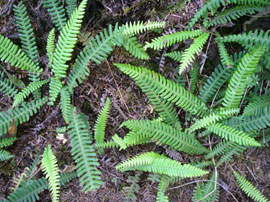
Blechnum spicant
Blechnum spicant is a species of fern known by the common names deer fern or hard fern. It is native to Europe and western North America. Like some other Blechnum it has two types of leaves. The sterile leaves have flat, wavy-margined leaflets, while the fertile leaves have much narrower leaflets. Deer fern is a major understory plant in most moist coniferous forests in our region.
- Light Requirements: Part Shade, Full Shade
- Water Requirements: Moist, Seasonally Wet
- Ease of Growing: Moderate
- Growth Rate: Slow
- Spreads: No
- Wildlife Support: Birds or Mammals
- Fire-resistant: Yes
- Edible: No
- Mature Height: 1-3ft
- Mature Width:2ft
Blue-eyed Grass
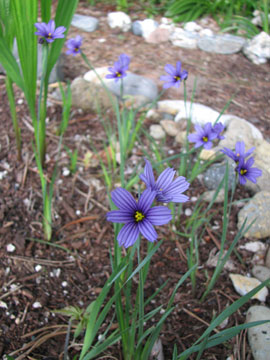
Sisyrinchium idahoense
This plant is not a true grass but has a grass-like appearance as it is low-growing with long, thin leaves. They often grow on grasslands and resemble iris, a close relative. The flower is a deep bluish-purple to blue-violet and rarely white. The fruit is a dry dark or pale-brown capsule with one to several seeds in a locule. It blooms from March to May and is quite variable.
- Light Requirements: Full Sun, Part Shade
- Water Requirements: Moist, Seasonally Wet
- Ease of Growing: Easy to grow
- Growth Rate: Fast
- Spreads: Yes
- Wildlife Support: Pest-eating Insects
- Fire-resistant: Yes
- Edible:
- Mature Height: 8-12in
- Mature Width:6-12in
Slough Sedge

Carex Obnupta
Slough sedge is native to western North America from British Columbia to California where it grows in wetland habitats. The plant produces upright, angled stems approaching 1.2 meters in maximum height, growing in beds or colonies from rhizome networks. The inflorescence is a cluster of flower spikes accompanied by a long leaflike bract.
Wildlife
The lens-shaped seeds are eaten by many kinds of wildlife. Birds known to eat sedge seeds include coots, ducks, marsh birds, shorebirds, upland game birds, and songbirds. In addition to providing food for many wildlife species, sedges are also valuable for cover. Frequently they provide nesting cover for ducks, and their tufted growth furnishes concealment and bedding for other animals. Beavers, otters, muskrats and minks make their way through the sedges as they go to and from the water.
Ethnobotanic
The leaves of slough sedge are used for both wrapping and twining in the grass baskets that are well known and widely marketed by Nitinaht and Nootka women even today.
The Nitinaht believed that picking grasses such as slough sedge for baskets and mats causes fog. The fisherman were always getting annoyed with the women who harvested these materials, because they were always making it foggy. It is said that Hesaquiat men shaved with this grass because the edges are so sharp. There is a saying in Hesaquiat which translates as “you’re just like citapt (slough sedge)” – you never change, because slough sedge is always the same and never seems to change in appearance.
Erosion Control
Slough sedge provides erosion control and streambank stabilization. The dense swards of slough sedge provide sediment retention and nutrient uptake, thus contributing to water quality improvement. Emergent wetland plant communities dominated by slough sedge provide the following hydrologic functions: maintaining river or stream meander patterns; providing a broad, shallow plain where streams slow and sediment deposition occurs; stormwater abatement; a mixing zone where brackish and freshwaters meet; and nutrient-rich habitat for aquatic organisms, fish, waterfowl, and predators such as otter, bald eagles, herons, and raccoons to feed.
- Light Requirements: Full Sun, Part sun
- Water Requirements: Perennially Wet
- Ease of Growing: Easy to grow
- Growth Rate: Moderate
- Spreads:
- Wildlife Support: Birds or Mammals
- Fire-resistant: No
- Edible: No
- Mature Height: 2ft
- Mature Width:1ft

